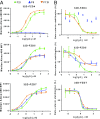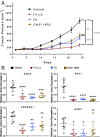Structure-guided design fine-tunes pharmacokinetics, tolerability, and antitumor profile of multispecific frizzled antibodies
- PMID: 30894493
- PMCID: PMC6452705
- DOI: 10.1073/pnas.1817246116
Structure-guided design fine-tunes pharmacokinetics, tolerability, and antitumor profile of multispecific frizzled antibodies
Abstract
Aberrant activation of Wnt/β-catenin signaling occurs frequently in cancer. However, therapeutic targeting of this pathway is complicated by the role of Wnt in stem cell maintenance and tissue homeostasis. Here, we evaluated antibodies blocking 6 of the 10 human Wnt/Frizzled (FZD) receptors as potential therapeutics. Crystal structures revealed a common binding site for these monoclonal antibodies (mAbs) on FZD, blocking the interaction with the Wnt palmitoleic acid moiety. However, these mAbs displayed gastrointestinal toxicity or poor plasma exposure in vivo. Structure-guided engineering was used to refine the binding of each mAb for FZD receptors, resulting in antibody variants with improved in vivo tolerability and developability. Importantly, the lead variant mAb significantly inhibited tumor growth in the HPAF-II pancreatic tumor xenograft model. Taken together, our data demonstrate that anti-FZD cancer therapeutic antibodies with broad specificity can be fine-tuned to navigate in vivo exposure and tolerability while driving therapeutic efficacy.
Keywords: Frizzled receptors; Wnt signaling; X-ray crystallography; antibody therapeutic; protein engineering.
Conflict of interest statement
Conflict of interest statement: The authors have filed a patent application for the antibodies described in this work.
Figures





Similar articles
-
A synthetic anti-Frizzled antibody engineered for broadened specificity exhibits enhanced anti-tumor properties.MAbs. 2018 Nov-Dec;10(8):1157-1167. doi: 10.1080/19420862.2018.1515565. Epub 2018 Sep 25. MAbs. 2018. PMID: 30183492 Free PMC article.
-
Cell growth inhibition and apoptosis in breast cancer cells induced by anti-FZD7 scFvs: involvement of bioinformatics-based design of novel epitopes.Breast Cancer Res Treat. 2018 Jun;169(3):427-436. doi: 10.1007/s10549-017-4641-6. Epub 2018 Feb 6. Breast Cancer Res Treat. 2018. PMID: 29411237
-
Frizzled-7 Is Required for Wnt Signaling in Gastric Tumors with and Without Apc Mutations.Cancer Res. 2019 Mar 1;79(5):970-981. doi: 10.1158/0008-5472.CAN-18-2095. Epub 2019 Jan 8. Cancer Res. 2019. PMID: 30622113
-
Wnt/Frizzled signaling in hepatocellular carcinoma.Front Biosci. 2006 May 1;11:1901-15. doi: 10.2741/1933. Front Biosci. 2006. PMID: 16368566 Review.
-
Fatty acid recognition in the Frizzled receptor family.J Biol Chem. 2019 Jan 11;294(2):726-736. doi: 10.1074/jbc.REV118.005205. Epub 2018 Dec 10. J Biol Chem. 2019. PMID: 30530496 Free PMC article. Review.
Cited by
-
A New Wave of Targeting 'Undruggable' Wnt Signaling for Cancer Therapy: Challenges and Opportunities.Cells. 2023 Apr 8;12(8):1110. doi: 10.3390/cells12081110. Cells. 2023. PMID: 37190019 Free PMC article. Review.
-
Review Article: Is Wnt Signaling an Attractive Target for the Treatment of Osteoarthritis?Rheumatol Ther. 2020 Jun;7(2):259-270. doi: 10.1007/s40744-020-00205-8. Epub 2020 Apr 10. Rheumatol Ther. 2020. PMID: 32277404 Free PMC article. Review.
-
Antiepileptic Drug Carbamazepine Binds to a Novel Pocket on the Wnt Receptor Frizzled-8.J Med Chem. 2020 Mar 26;63(6):3252-3260. doi: 10.1021/acs.jmedchem.9b02020. Epub 2020 Feb 25. J Med Chem. 2020. PMID: 32049522 Free PMC article.
-
Carboxylesterase Notum Is a Druggable Target to Modulate Wnt Signaling.J Med Chem. 2021 Apr 22;64(8):4289-4311. doi: 10.1021/acs.jmedchem.0c01974. Epub 2021 Mar 30. J Med Chem. 2021. PMID: 33783220 Free PMC article.
-
An atlas of CNV maps in cattle, goat and sheep.Sci China Life Sci. 2021 Oct;64(10):1747-1764. doi: 10.1007/s11427-020-1850-x. Epub 2021 Jan 21. Sci China Life Sci. 2021. PMID: 33486588
References
-
- Dravid G, et al. Defining the role of Wnt/beta-catenin signaling in the survival, proliferation, and self-renewal of human embryonic stem cells. Stem Cells. 2005;23:1489–1501. - PubMed
-
- Logan CY, Nusse R. The Wnt signaling pathway in development and disease. Annu Rev Cell Dev Biol. 2004;20:781–810. - PubMed
-
- Clevers H, Loh KM, Nusse R. Stem cell signaling. An integral program for tissue renewal and regeneration: Wnt signaling and stem cell control. Science. 2014;346:1248012. - PubMed
Publication types
MeSH terms
Substances
Associated data
- Actions
- Actions
- Actions
Grants and funding
LinkOut - more resources
Full Text Sources
Other Literature Sources
Medical

